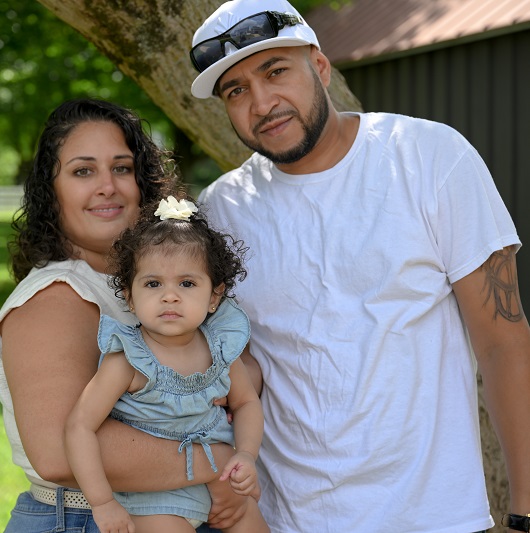A Double Dose of Robotic Surgery

July 25, 2024
When he needed surgery, retired operating room nurse Anthony Taglieri chose Bayshore Medical Center’s general surgery experts to perform his robotic-assisted gallbladder and hernia procedures
Anthony Taglieri, 79, is a retired registered nurse from Aberdeen, New Jersey — and after caring for patients in the hospital and operating room for 37 years, he can easily identify the signs and symptoms of many common health conditions. So, when he was awakened one night at 2 a.m. with severe abdominal pain, he immediately suspected a gallbladder attack.
“I had a similar attack two years previously, and my doctors warned me that it might happen again,” said Anthony.
This time, however, the pain was so severe that he asked his wife to take him to the Emergency Department at Bayshore Medical Center.
“When I got to the emergency room, the team started an IV, administered pain medication and took blood for labs,” said Anthony.
As Anthony suspected, he was diagnosed with cholecystitis and needed an emergency cholecystectomy to remove his gallbladder.
Hitting It Off
Anthony was admitted to the hospital and met with Jessica Treto, M.D., general surgeon, who was on call at the time. Dr. Treto performed an exam and reviewed Anthony’s lab results and images.
“Dr. Treto explained the procedure — which would be performed using minimally invasive robotic surgery techniques — in a very comprehensive and precise way, and scheduled my surgery for 11 a.m. the following day,” said Anthony. “From the minute she walked into my room, I felt comfortable with Dr. Treto — especially after she told me she had performed a couple hundred of these procedures. When she realized I was a nurse, we really hit it off.”
Because he only had a few small incisions, Anthony said he recovered quickly after his gallbladder procedure. Although he returned to normal activities within a few days, he had to avoid heavy lifting for four weeks.
“Robotic surgery is performed through very small incisions, which means patients recover faster,” said Dr. Treto. “We have a magnified view of the surgical area and can perform procedures with increased precision.”
However, during Anthony’s follow-up visit with Dr. Treto at her office, she noticed another condition that would eventually require surgical care.
“I am a colon cancer survivor who was diagnosed in 2017, and I have a permanent ostomy (a surgical opening) in my abdomen,” said Anthony. “When I saw Dr. Treto for my gallbladder follow-up, she pointed out that I had a hernia at my ostomy site that may eventually need to be fixed. She told me to keep an eye on the hernia, and to call if I have any pain or notice that it is getting larger.”
An Out-of-Town Emergency
A few months later, Anthony and his wife headed to Myrtle Beach for a vacation. While sitting on his balcony a few days after they arrived in South Carolina, Anthony noticed some discomfort in his abdomen.
“I said to my wife, ‘I think we have to go to the hospital,’” said Anthony.
After he arrived at the hospital in South Carolina, Anthony experienced several episodes of projectile vomiting that looked like coffee grounds. His extensive nursing experience, training, and education led him to suspect he had a small bowel obstruction caused by an incarcerated hernia. This occurs when part of the small intestine becomes trapped in the abdominal wall, preventing stool from passing through the intestine.
One of the physicians was able to reposition the hernia and resolve the obstruction temporarily. “However, I knew I needed to head home to see Dr. Treto to have the hernia repaired, and when I called, she said she could see me the following day,” said Anthony.
“Since Anthony wasn’t in any pain and his obstruction had resolved, we decided to perform his robotic-assisted hernia procedure electively the following week,” said Dr. Treto.
Choosing High-Quality Care
Just like his experience with his first robotic-assisted procedure, Anthony recovered quickly.
“Other than a little stinging during the first 24 hours after surgery, I’ve had no problems since,” said Anthony. “Meeting Dr. Treto was the luck of the draw, but I am so grateful that she is my surgeon — and that I chose to go to my community hospital for my care.”
“Anthony did exceptionally well after both of his procedures,” said Dr. Treto. “As a retired nurse, Anthony is a patient who is well-versed in what to expect from surgical care. His decision to receive his care at Bayshore speaks to the expertise, growth and quality of our robotic general surgery program.”
Both Anthony and Dr. Treto want to raise awareness about the benefits of robotic surgery, as well as its availability at Bayshore and other Hackensack Merdian Health hospitals.
“I firmly and passionately believe in the benefits of robotic surgery, which have been proven time and time again,” said Dr. Treto. “Bringing robotic surgical technology and expertise to community hospitals such as Bayshore promotes equality in health care access — so all patients can receive this level of care in their own backyard.”
Next Steps & Resources
- Meet our source: Jessica Treto, M.D.
- To make an appointment with a surgeon near you, call 800-822-8905 or visit our website.
- Learn more about robotic surgery at Hackensack Meridian Health
The material provided through HealthU is intended to be used as general information only and should not replace the advice of your physician. Always consult your physician for individual care.






